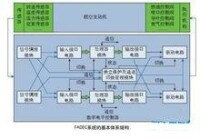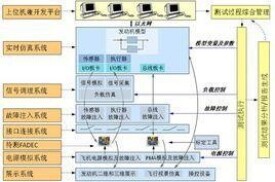FADEC
由燃油計量組件等組成的系統
為了增加發動機的可靠性和效率,當和飛機的分系統結合操作時,全許可權數字式發動機控制(FADEC)提供發動機控制的全許可權來達到穩定和瞬態的發動機特性。
20世紀70年代初,英國開始研製數字式電子控制(FADEC)系統。繼而,美國等國家也紛紛進入,美國後來居上,一直處於比較領先的地位。
20世紀80年代初,中國才真正展開高性能推進系統數字控制的研究,現在已初步掌握了各項關鍵技術,但總體來說,尚處於技術突破階段。
全許可權數字發動機控制器(Full Authority Digital Engine Control)FADEC,是相對於傳統的發動機液壓控制系統來說的。傳統的液壓控制系統實現控制規律演演算法主要依靠凸輪的空間曲面來完成,而這個空間曲面構型製造比較困難,因而液壓控制系統控制精度不高。FADEC實現控制規律演演算法則簡單的多,只需把公式變成代碼進行處理即可,因而控制精度要高很多。

FADEC系統的基本體系結構
FADEC系統有雙通道的EEC和以下的外部設備:
-燃油計量組件(FMU)
-專門的FADEC交流發電機
-壓氣機控制系統
-間隙控制系統
-起動系統(起動機關斷活門、點火激發器)
-反推系統
-熱管理系統
-電氣導線系列
航空發動機控制正處於從傳統的液壓機械式控制向數字電子控制的轉變階段,並且經歷了從單個部件到整體、從模擬式到數字式、從有限功能到全權控制的發展過程。可以預測,無論在軍用機上,還是在民用機、直升機乃至航機陸用裝置上,今後將越來越多地採用發動機電子控制系統,尤其是全許可權數字電子控制系統,將使航空發動機控制技術達到更新、更高的水平。

FADEC
A typical civilian transport aircraft flight may illustrate the function of a FADEC. The flight crew first enters flight data such as wind conditions,runwaylength, or cruise altitude, into theflight management system(FMS). The FMS uses this data to calculate power settings for different phases of the flight. At takeoff, the flight crew advances the throttle to a predetermined setting, or opts for an auto-throttle takeoff if available. The FADECs now apply the calculated takeoff thrust setting by sending an electronic signal to the engines; there is no direct linkage to open fuel flow. This procedure can be repeated for any other phase of flight.
In flight, small changes in operation are constantly made to maintain efficiency. Maximum thrust is available for emergency situations if the throttle is advanced to full, but limitations can’t be exceeded; the flight crew has no means of manually overriding the FADEC
True full authority digital engine controls have no form of manual override available, placing full authority over the operating parameters of the engine in the hands of the computer. If a total FADEC failure occurs, the engine fails. If the engine is controlled digitally and electronically but allows for manual override, it is considered solely an EEC orECU. An EEC, though a component of a FADEC, is not by itself FADEC. When standing alone, the EEC makes all of the decisions until the pilot wishes to intervene.
FADEC works by receiving multiple input variables of the current flight condition includingair density, throttle lever position, engine temperatures, engine pressures, and many other parameters. The inputs are received by the EEC and analyzed up to 70 times per second. Engine operating parameters such as fuel flow, stator vane position,bleed valveposition, and others are computed from this data and applied as appropriate. FADEC also controls engine starting and restarting. The FADEC's basic purpose is to provide optimum engine efficiency for a given flight condition.
FADEC not only provides for efficient engine operation, it also allows the manufacturer to program engine limitations and receive engine health and maintenance reports. For example, to avoid exceeding a certain engine temperature, the FADEC can be programmed to automatically take the necessary measures without pilot intervention.
